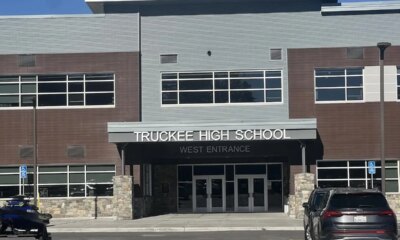California
New California “Auto Fire” breaks out in Ventura County

Firefighters in California are tackling a new fire that has broken out in Ventura County.
The blaze, dubbed the Auto fire, started in the Santa Clara River bottom near North Ventura Boulevard and Auto Center Drive, on Monday evening.
Progress on the fire had been “significantly slowed” by 10:50 p.m. local time on Monday, Andrew Dowd, a spokesperson for the Ventura County Fire Department, told the Ventura County Star.
A cause for the fire has not been determined, Dowd said.
Newsweek has contacted the fire department for further information via email.
Why It Matters
The new fire came as strong winds threatened the progress made so far on huge fires in the Los Angeles area that have destroyed thousands of homes and killed at least 24 people in the past week.
The Palisades fire, the largest of the fires still burning, has consumed almost 24,000 acres west of Los Angeles, and was just 14 percent contained by Monday night. The Eaton fire has burned more than 14,000 acres in the hills near Pasadena and was just 33 percent contained, while containment on the Hurst fire, which has burned almost 800 acres near Sylmar, was at 97 percent.
What To Know
Several videos posted on social media showed the spread of the fire.
One video captured from a helicopter and shared on X by ABC7 reporter Chris Cristi showed the fire moving west along the Santa Clara riverbed.
BREAKING: A fast moving, wind driven brush fire is racing West along the Santa Clara riverbed between Ventura and Oxnard, toward Victoria Ave bridge. 3 helicopters assigned to the #AutoFire pic.twitter.com/bBZJNTCzU0
— Chris Cristi (@abc7chriscristi) January 14, 2025
Local news station KTLA also shared a video captured from above showing how far the blaze had spread.
About 75 firefighters were working to prevent the spread of the fire, the Ventura County Fire Department wrote on X shortly before 9 p.m. local time.
An evacuation order has been issued for the Santa Clara River between the 101 Freeway and Victoria Avenue, according to an alert on the Ventura County’s emergency services website.
The alert notes that no residential structures are under evacuation.
Victoria Avenue is closed between Gonzales Road and Olivas Park Drive, the alert added.
AP
What People Are Saying
Dowd told the Star that he did not expect the fire to threaten any structures. “Because of the size, it will be a long night of hard work to get the heat out of certain portions of this fire,” he said.
What’s Next
Firefighters are continuing to work on containing the Auto fire. It had burned about 56 acres and containment was at 0 percent, according to an update from Cal Fire at around 11:40 p.m.
Update 1/14/25, 3.30 a.m. ET: This article has been updated with additional information.

California
Missing California 9-year-old Melodee Buzzard found dead, grandmother says

Melodee Buzzard, the 9-year-old whose disappearance was reported by Santa Barbara County educators in October, has been found dead, a relative confirmed to The Times on Tuesday.
Melodee vanished during an unusual road trip with her mother earlier this year, sparking a months-long investigation.
Her disappearance captivated and confounded true crime watchers around the nation as FBI investigators and armchair detectives alike tried to solve the puzzle of what happened.
On Tuesday, Melodee’s paternal grandmother confirmed to The Times that her body has been found by investigators.
“The detective called me this morning to let me know that they found the baby and the baby is with her dad,” said Melodee’s grandmother Lilly Denes. “I knew he was telling me that the baby is dead.”
Melodee’s father, Rubiell “Pinoy” Meza, died in a motorcycle accident in 2016.
Local TV news station KSBY captured video of Melodee’s mother Ashlee Buzzard being taken into custody shortly before 7:45 a.m. Tuesday. During the road trip earlier this year, Buzzard changed out the license plates on her rental car and wore wigs in what detectives described as possible attempts to avoid detection, according to the Santa Barbara County Sheriff’s Office.
The Sheriff’s Office did not immediately respond to a request for comment, but has planned a 2 p.m. news conference to provide updates on the case. Here is what we know about the events that led up to Tuesday’s tragic discovery.
Ashlee Buzzard’s ‘hard knock’ childhood
When Ashlee Buzzard was just 9 years old — the same age as her daughter Melodee when she went missing — she and her mother, Lori Miranda, became homeless after fleeing Buzzard’s abusive father, Miranda told the Santa Maria Times in 1995.
The article, titled “Lessons From the School of Hard Knocks,” describes how Miranda and her daughter arrived on the streets of Santa Maria with no job, home or car and only $40 to support them.
They had previously moved from place to place to get away from Miranda’s husband, who she said struggled with substance use and episodes of violence. In June 1994, Miranda decided to take her daughter from Orange County to the Central Coast to be farther away from him, and they briefly lived at the Good Samaritan Shelter in Santa Maria before moving into an apartment.
“I was so scared,” Ashlee told the paper, describing her early days in Santa Maria. “I knew no one [here]. I felt very uncomfortable.”
According to Melodee’s paternal relatives, Buzzard had a contentious relationship with her mother.
When Buzzard was in the 11th grade at Santa Maria High School, she filed a petition to be emancipated from Miranda, according to court records. The judge rejected the petition, noting that Buzzard was still living with her mother and had not submitted adequate information pertaining to her income and expenses.
A birth and a sudden death
Melodee was born Feb. 10, 2016, to Buzzard and Meza. Six months later, Meza died.
In Melodee’s early years, Meza’s family continued to have a relationship with the girl, according to Denes. She was a lovable child, always smiling and well-behaved, Denes said.
Lilly Denes, the paternal grandmother of missing California girl Melodee Buzzard, in her home in Orcutt on Nov. 6.
(Carlin Stiehl / For The Times)
In 2021, another of Denes’ sons took care of Melodee while Buzzard was hospitalized for several weeks, she said.
During this period, Denes said she was working with social services to gain custody of Melodee as she was concerned about Buzzard’s ability to care for the child. But before Denes had finished the background check process, Buzzard was discharged from the hospital, picked up her daughter from school and left Santa Maria, Denes said.
After that, Buzzard relocated to the nearby neighborhood of Vandenberg Village and refused to let the girl’s paternal relatives see her. She did, however, occasionally visit Denes to ask for money over the years, Denes said.
Federal court records show that Buzzard filed for Chapter 7 bankruptcy in 2017. She’s also had five collections and one small claims lawsuit for alleged unpaid debts filed against her in Santa Barbara County Superior Court, the most recent of which was filed by Capital One Bank in May.
In August, Buzzard enrolled Melodee in an independent study program at the Lompoc Unified School District. Sheriff’s detectives believe that she had previously been homeschooling the girl for several years, but the California Department of Education has no record of her submitting the required paperwork to do so, according to a department spokesperson.
A strange cross-country road trip

Melodee Buzzard was captured on surveillance camera apparently wearing a wig at a car rental location in Lompoc on Oct. 7.
(Santa Barbara County Sheriff)
On Oct. 7, Buzzard and Melodee left their Vandenberg Village home and traveled to Nebraska, according to the Sheriff’s Office. During the trip, Buzzard switched out the California license plates (9MNG101) on the car with New York plates (HCG9677). When she returned home Oct. 10, the original plates were reaffixed, according to the Sheriff’s Office.
Both Melodee and Buzzard were apparently wearing wigs during the journey and the mother reportedly changed wigs throughout, according to the Sheriff’s Office. The last confirmed sighting of Melodee was on Oct. 9, when she was seen on surveillance video near the Utah-Colorado border.
The investigation
On Oct. 14, school administrators reported Melodee’s prolonged absence from her independent study program to the Sheriff’s Office.
Investigators then visited Buzzard’s home, where the mother refused to answer questions about her daughter’s whereabouts, according to the Sheriff’s Office.
On Oct. 30, the FBI joined the case and assisted the Sheriff’s Office in serving search warrants for Buzzard’s home, the rental car and a storage locker.
Detectives then mapped out Buzzard’s road trip route and focused on the return route, from where Melodee was last seen in Utah to Vandenberg Village.

Investigators believe that Buzzard traveled through the following areas on or around Oct. 9: Green River, Utah; Panguitch, Utah; Northwest Arizona; Primm, Nev.; Rancho Cucamonga.
(Santa Barbara County Sheriff)
During October, relatives and concerned community members often gathered around Buzzard’s home, chanting, “Where is Melodee” and leaving posters with messages such as “Bring her home.” The investigation became a national sensation, with videos produced by true crime sleuths racking up thousands of views on TikTok and Instagram.
Buzzard arrested following accusations of false imprisonment
Buzzard was arrested Nov. 7 in an incident unrelated to the investigation into her daughters disappearance, according to the Sheriff’s Office.
She was accused of unlawfully violating the personal liberty of Tyler S. Brewer after disclosing sensitive information to him.
Brewer, a paralegal and acquaintance of Buzzard, said in a statement that he visited Buzzard at her home to offer assistance in the search for the missing girl, and that the situation quickly escalated.
But at a hearing in November, a Santa Barbara County Superior Court judge dismissed the case after new evidence came to light that called his version of events into question.
“After the initial report to law enforcement and the filing of the complaint, further investigation yielded additional evidence that was contradictory to the information that was initially provided to detectives,” said Amber Frost, a spokesperson for the Santa Barbara district attorney’s office.
“That evidence was brought out at the hearing and inconsistencies were examined by both sides. Ultimately, it was determined that the evidence was not sufficient to move this case forward to trial,” Frost said.
Times staff writer Terry Castleman contributed to this report.
California
Placer County crews rescue baby, family from home surrounded by raging river

PLACER COUNTY, Calif. (KGO) — Heavy rain and flooding impacted Northern California over the weekend, leading to rescues and evacuations throughout the region.
In Placer County, emergency crews carefully and slowly rescued a baby in a carrier, sliding it on a ladder over a rushing river.
The raging South Yuba River overtook the home, where nine people were rescued by the Truckee Fire Protection District.
As of Monday morning, the Placer County Sheriff’s Office said an evacuation warning continues to be in effect for areas along the South Yuba River between Donner Pass Road and Cisco Road.
The storm is also swamping parts of Humboldt County, where the sheriff’s office shared pictures of goats stranded on someone’s doorstep.
This is near the Freshwater area – near Arcata, where high water forced several evacuations.
Crews arrived in jet skis to assist residents.
In Redding, one person died after major flooding.
Water took over streets and entire neighborhoods.
Several people had to be rescued, and Interstate 5 was also flooded, impacting holiday drivers.
LIVE UPDATES: Storms flood parts of NorCal with heavy rain as alerts expand to entire Bay Area
In Mendocino County, Willits received more than 6 inches of rain in 48 hours, flooding parks in the area.
With more rain in the forecast, rescue crews are prepared and people are reminded not to ever drive through standing water.
Copyright © 2025 KGO-TV. All Rights Reserved.
California
Flash flooding in Northern California leads to soaked roads, water rescues and a death

REDDING, Calif. — Heavy rain and flash flooding soaked roads in northern California, leading to water rescues from vehicles and homes and at least one confirmed death, authorities said Monday.
In Redding, a city at the northern end of the Central Valley, one motorist died after calling 911 while trapped in their vehicle as it filled up with water, Mayor Mike Littau posted online Monday. Police said they received numerous calls for drivers stranded in flooded areas.
“Redding police officer swam out into the water, broke the windows and pulled victim to shore. CPR was done but the person did not live,” Littau wrote.
The weather in the coming days could be even more dangerous, he warned.
The National Weather Service expected more rain through the Christmas week as a series of atmospheric rivers was forecast to make its way through Northern California. A large swath of the Sacramento Valley and surrounding areas were under a flood watch through Friday.
The weather pattern was expected to intensify by midweek, which could lead to potential mudslides, rockslides and flooding of creeks and streams, forecasters warned. Up to 6 feet of snow was predicted for parts of the Sierra Nevada and winds could reach 55 mph in high elevations by Wednesday.
Southern California can also expect a soggy Christmas, with heavy rain in the forecast starting Tuesday evening. The National Weather Service urged people to make backup plans for holiday travel.
In Redding and surrounding areas, between 3 and 6 inches had fallen by Sunday night, the National Weather Service said.
As of Monday morning, local roads in Redding remained flooded as street crews worked to clear debris and tow out abandoned cars.
Dekoda Cruz waded in knee-deep muddy water to check on a friend’s flooded tire business, where the office was littered with a jumble of furniture and bobbing tires.
In the mountain pass area of Donner Summit, firefighters in Truckee extended a ladder to stranded residents at a house along the South Yuba River, the fire department posted online Sunday. No injuries were reported.
Atmospheric rivers are long, narrow bands of water vapor that form over an ocean and flow through the sky, transporting moisture from the tropics to northern latitudes.
Earlier this month, stubborn atmospheric rivers that drenched Washington state with nearly 5 trillion gallons of rain in a week, threatening record flood levels, meteorologists said. That rainfall was supercharged by warm weather and air plus unusual weather conditions tracing back as far as a tropical cyclone in Indonesia.
-

 Iowa1 week ago
Iowa1 week agoAddy Brown motivated to step up in Audi Crooks’ absence vs. UNI
-

 Maine1 week ago
Maine1 week agoElementary-aged student killed in school bus crash in southern Maine
-

 Maryland1 week ago
Maryland1 week agoFrigid temperatures to start the week in Maryland
-

 New Mexico1 week ago
New Mexico1 week agoFamily clarifies why they believe missing New Mexico man is dead
-

 South Dakota1 week ago
South Dakota1 week agoNature: Snow in South Dakota
-

 Detroit, MI1 week ago
Detroit, MI1 week ago‘Love being a pedo’: Metro Detroit doctor, attorney, therapist accused in web of child porn chats
-

 Health1 week ago
Health1 week ago‘Aggressive’ new flu variant sweeps globe as doctors warn of severe symptoms
-

 Maine1 week ago
Maine1 week agoFamily in Maine host food pantry for deer | Hand Off

























